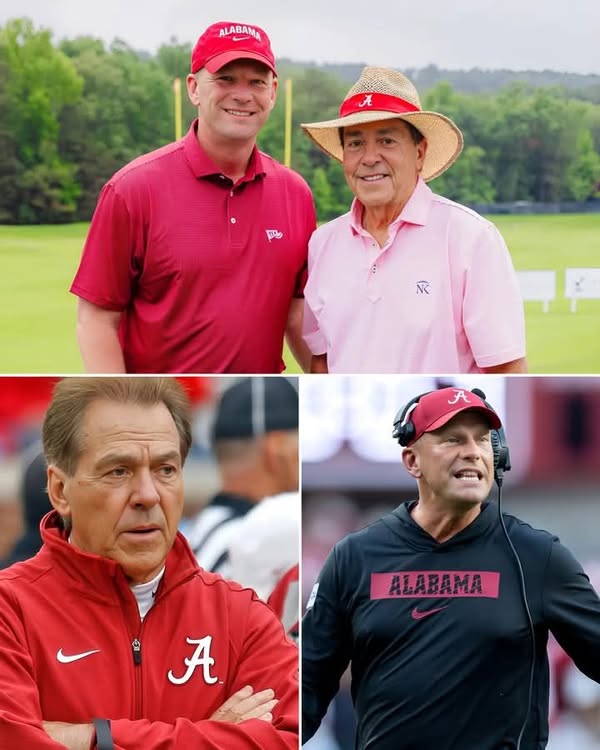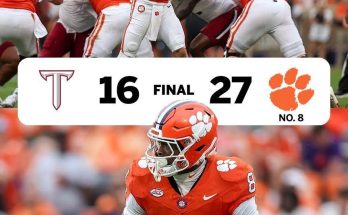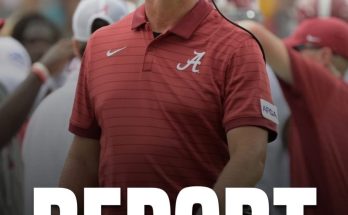There were no sweeping declarations or dramatic promises. No chest-pounding or bravado. Instead, DeBoer stood in front of a podium, wearing a crimson tie and a quiet confidence, and calmly stated that he was here to win championships. He acknowledged the magnitude of the moment—the enormity of stepping into the shoes of the most decorated coach in college football history—but didn’t flinch. He spoke not as someone inheriting a dynasty, but as someone prepared to continue building one.
That moment wasn’t just the beginning of a new era for Alabama football. It was the ignition of a carefully calculated plan, a vision shaped by years of methodical success, discipline, and adaptability. DeBoer wasn’t hired to replicate Nick Saban. He was hired to lead Alabama into its next chapter.
Replacing a titan like Saban—seven national championships, six at Alabama, a coach who turned the Crimson Tide into a modern-day football empire—is perhaps the most daunting job in college athletics. Every step taken by DeBoer would inevitably be measured against the unrelenting shadow cast by Saban’s greatness. But Alabama athletic director Greg Byrne didn’t choose DeBoer to be the next Saban. He chose him because he believed DeBoer could win in his own way.
At Washington, DeBoer led a remarkable resurgence, turning a struggling Pac-12 program into a national powerhouse in just two seasons. He compiled a 25-3 record, including a perfect regular season in 2023 and a berth in the College Football Playoff National Championship game. His offense, led by Heisman finalist Michael Penix Jr., was one of the most explosive in the country. But more impressive than the wins was the culture shift. Players played with discipline, intelligence, and resilience—hallmarks of DeBoer-led teams throughout his career.
DeBoer’s journey to Tuscaloosa wasn’t a traditional one. Born in Milbank, South Dakota, he cut his teeth as a coach at the University of Sioux Falls, an NAIA program where he won three national championships in five years. From there, he climbed the coaching ladder—Indiana, Fresno State, and finally Washington—rising not because of flash, but because of consistent results. Everywhere he went, teams improved. Wins followed. Players bought in. Administrators took notice.
When he arrived at Alabama, the program was already in a transitional moment. Nick Saban’s retirement shocked the college football world. Though he had hinted at slowing down, few believed it would actually happen. His departure left a gaping void—one not just of leadership but of identity. For nearly two decades, Saban was Alabama football. He transformed the Crimson Tide into the gold standard, where every detail was meticulously managed, every player developed with purpose, and every Saturday treated like a business trip.
DeBoer inherited that standard. But he also inherited the pressure, the expectations, and a locker room full of players who had committed to Saban’s vision. His first challenge was internal: convincing those players, and the fanbase, that he was worthy of the throne. And he did it not by force, but by forging genuine relationships, building trust, and maintaining many of the core values that had made Alabama elite while slowly introducing his own methods.
There were early bumps, as expected. Several players entered the transfer portal following Saban’s retirement. DeBoer faced a flurry of questions: Could he recruit at an SEC level? Could he win in the cutthroat landscape of Southern football? Could his pass-heavy offense work in a league dominated by defensive powerhouses? But instead of panicking, he went to work.
He retained key assistants, including defensive coordinator Kane Wommack, to preserve some continuity. He hit the transfer portal strategically, filling needs with proven talent rather than making splashy but risky signings. On the recruiting trail, he embraced Alabama’s brand while promoting his own authenticity—a coach who had built winners at every stop without ever pretending to be someone he wasn’t.
Then came spring ball. For the first time, Alabama fans got to see a DeBoer-run practice. The tempo was quick. The communication was sharp. Quarterbacks were active, receivers precise, linemen agile. Though different from Saban’s defensive grind, the energy was unmistakable. Players responded with enthusiasm. DeBoer was hands-on, often pausing drills to give instruction, challenging veterans and newcomers alike to elevate their games.
As summer approached, optimism began to replace anxiety. Insiders noted the calm professionalism DeBoer brought to the facility each day. He wasn’t trying to be a celebrity. He didn’t seek headlines. He just wanted to coach football, the way he always had—with structure, clarity, and an unshakeable belief in preparation.
Fans, meanwhile, were watching closely. In Tuscaloosa, football isn’t just a sport; it’s a religion. Saturdays at Bryant-Denny Stadium are sacred. Fall conversations revolve around the Tide’s depth chart, rankings, and national title chances. For the last 17 years, those conversations always ended with the same belief: Alabama would find a way to win, because Nick Saban was on the sideline.
Now, there’s a new man wearing the headset. And while the legacy of Saban still lingers—his influence felt in the locker room, the training table, even in the game-day rituals—Kalen DeBoer is beginning to make his mark.
One of the most noticeable shifts has been the offensive philosophy. DeBoer’s system, rooted in spacing, tempo, and quarterback efficiency, is a contrast from the grind-it-out approach of early Saban teams. That’s not to say Saban didn’t adapt—his later years featured high-octane offenses under coordinators like Steve Sarkisian and Lane Kiffin—but DeBoer’s scheme is inherently aggressive. It demands a high level of execution from quarterbacks and puts pressure on defenses in multiple ways.
The question now is who will lead that offense. The quarterback competition is one of the most talked-about topics heading into fall camp. With several highly touted signal-callers on the roster, including returners and transfers, DeBoer faces a critical decision. His history suggests he’ll choose the player who makes the fewest mistakes and maximizes the system—not necessarily the one with the biggest arm or most stars by his name.
Defensively, Alabama will retain many of the same principles that made it dominant under Saban. Physicality at the point of attack, discipline in the secondary, and a deep rotation of athletic pass-rushers remain foundational. But expect to see more situational flexibility and an emphasis on turnovers—an area DeBoer has always prioritized.
In terms of culture, perhaps the biggest change has been tone. Where Saban ruled with an iron fist, demanding perfection and often using fear as a motivator, DeBoer operates with a quieter intensity. He listens. He empowers assistants. He believes in player ownership. That doesn’t mean expectations are lower—on the contrary, he holds his teams to a high standard—but his approach is less authoritarian, more collaborative.



